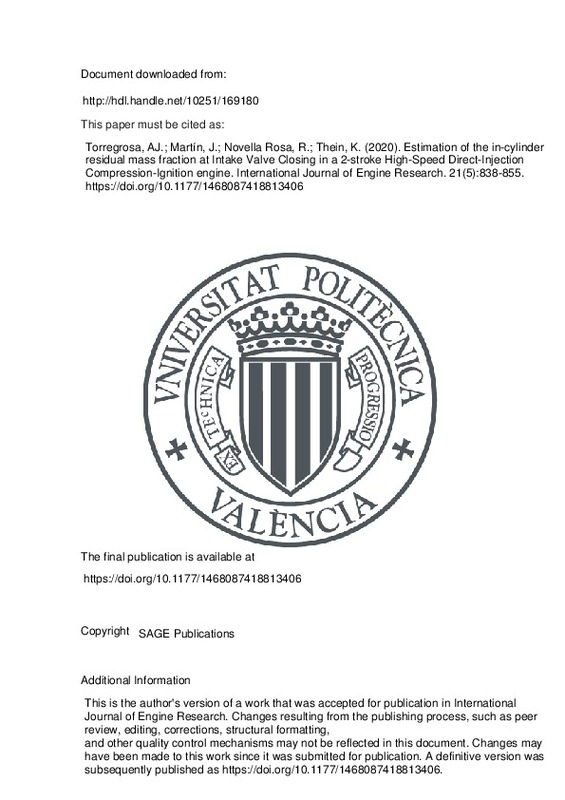Galindo, J., Luján, J. M., Serrano, J. R., & Hernández, L. (2005). Combustion simulation of turbocharger HSDI Diesel engines during transient operation using neural networks. Applied Thermal Engineering, 25(5-6), 877-898. doi:10.1016/j.applthermaleng.2004.08.004
Payri, F., Benajes, J., Galindo, J., & Serrano, J. R. (2002). Modelling of turbocharged diesel engines in transient operation. Part 2: Wave action models for calculating the transient operation in a high speed direct injection engine. Proceedings of the Institution of Mechanical Engineers, Part D: Journal of Automobile Engineering, 216(6), 479-493. doi:10.1243/09544070260137507
Rakopoulos, C. ., Rakopoulos, D. ., Giakoumis, E. ., & Kyritsis, D. . (2004). Validation and sensitivity analysis of a two zone Diesel engine model for combustion and emissions prediction. Energy Conversion and Management, 45(9-10), 1471-1495. doi:10.1016/j.enconman.2003.09.012
[+]
Galindo, J., Luján, J. M., Serrano, J. R., & Hernández, L. (2005). Combustion simulation of turbocharger HSDI Diesel engines during transient operation using neural networks. Applied Thermal Engineering, 25(5-6), 877-898. doi:10.1016/j.applthermaleng.2004.08.004
Payri, F., Benajes, J., Galindo, J., & Serrano, J. R. (2002). Modelling of turbocharged diesel engines in transient operation. Part 2: Wave action models for calculating the transient operation in a high speed direct injection engine. Proceedings of the Institution of Mechanical Engineers, Part D: Journal of Automobile Engineering, 216(6), 479-493. doi:10.1243/09544070260137507
Rakopoulos, C. ., Rakopoulos, D. ., Giakoumis, E. ., & Kyritsis, D. . (2004). Validation and sensitivity analysis of a two zone Diesel engine model for combustion and emissions prediction. Energy Conversion and Management, 45(9-10), 1471-1495. doi:10.1016/j.enconman.2003.09.012
Gatowski JA, Balles EN, Chun KM, Nelson FE, Ekchian JA, Heywood JB. Heat release analysis of engine pressure data. SAE technical paper 841359, 1984.
Lapuerta, M., Armas, O., & Hernández, J. J. (1999). Diagnosis of DI Diesel combustion from in-cylinder pressure signal by estimation of mean thermodynamic properties of the gas. Applied Thermal Engineering, 19(5), 513-529. doi:10.1016/s1359-4311(98)00075-1
Arrègle, J., López, J. J., Garcı́a, J. M., & Fenollosa, C. (2003). Development of a zero-dimensional Diesel combustion model. Part 1: Analysis of the quasi-steady diffusion combustion phase. Applied Thermal Engineering, 23(11), 1301-1317. doi:10.1016/s1359-4311(03)00079-6
Arrègle, J., López, J. J., Garcı́a, J. M., & Fenollosa, C. (2003). Development of a zero-dimensional Diesel combustion model. Applied Thermal Engineering, 23(11), 1319-1331. doi:10.1016/s1359-4311(03)00080-2
Li J, Chae JO, Park SB, Paik HJ, Park JK, Jeong YS, et al. Effect of intake composition on combustion and emission characteristics of DI diesel engine at high intake pressure. SAE technical paper 970322, 1997.
Brown WL. Methods for evaluating requirements and errors in cylinder pressure measurement. SAE technical paper 670008, 1968.
Lancaster DR, Krieger RB, Lienesch JH. Measurement and analysis of engine pressure data. SAE technical paper 750026, 1975.
Ghojel, J., & Honnery, D. (2005). Heat release model for the combustion of diesel oil emulsions in DI diesel engines. Applied Thermal Engineering, 25(14-15), 2072-2085. doi:10.1016/j.applthermaleng.2005.01.016
Wu, Y., Wang, Y., Zhen, X., Guan, S., & Wang, J. (2014). Three-dimensional CFD (computational fluid dynamics) analysis of scavenging process in a two-stroke free-piston engine. Energy, 68, 167-173. doi:10.1016/j.energy.2014.02.107
Yuan, C., Feng, H., He, Y., & Xu, J. (2016). Combustion characteristics analysis of a free-piston engine generator coupling with dynamic and scavenging. Energy, 102, 637-649. doi:10.1016/j.energy.2016.02.131
Cheung HM, Heywood JB. Evaluation of a one-zone burn-rate analysis procedure using production SI engine pressure data. SAE technical paper 932749, 1993.
Brunt, M. F. J., Rai, H., & Emtage, A. L. (1998). The Calculation of Heat Release Energy from Engine Cylinder Pressure Data. SAE Technical Paper Series. doi:10.4271/981052
Payri, F., Molina, S., Martín, J., & Armas, O. (2006). Influence of measurement errors and estimated parameters on combustion diagnosis. Applied Thermal Engineering, 26(2-3), 226-236. doi:10.1016/j.applthermaleng.2005.05.006
Broatch, A., Ruiz, S., Margot, X., & Gil, A. (2010). Methodology to estimate the threshold in-cylinder temperature for self-ignition of fuel during cold start of Diesel engines. Energy, 35(5), 2251-2260. doi:10.1016/j.energy.2010.02.012
Olsen, D. B., Hutcherson, G. C., Willson, B. D., & Mitchell, C. E. (2002). Development of the Tracer Gas Method for Large Bore Natural Gas Engines—Part I: Method Validation. Journal of Engineering for Gas Turbines and Power, 124(3), 678-685. doi:10.1115/1.1454116
Olsen, D. B., Hutcherson, G. C., Willson, B. D., & Mitchell, C. E. (2002). Development of the Tracer Gas Method for Large Bore Natural Gas Engines—Part II: Measurement of Scavenging Parameters. Journal of Engineering for Gas Turbines and Power, 124(3), 686-694. doi:10.1115/1.1454117
Benajes, J., Olmeda, P., Martín, J., & Carreño, R. (2014). A new methodology for uncertainties characterization in combustion diagnosis and thermodynamic modelling. Applied Thermal Engineering, 71(1), 389-399. doi:10.1016/j.applthermaleng.2014.07.010
Payri, F., Olmeda, P., Martín, J., & García, A. (2011). A complete 0D thermodynamic predictive model for direct injection diesel engines. Applied Energy, 88(12), 4632-4641. doi:10.1016/j.apenergy.2011.06.005
Benajes, J., Novella, R., De Lima, D., Tribotté, P., Quechon, N., Obernesser, P., & Dugue, V. (2013). Analysis of the combustion process, pollutant emissions and efficiency of an innovative 2-stroke HSDI engine designed for automotive applications. Applied Thermal Engineering, 58(1-2), 181-193. doi:10.1016/j.applthermaleng.2013.03.050
Benajes, J., Martín, J., Novella, R., & Thein, K. (2016). Understanding the performance of the multiple injection gasoline partially premixed combustion concept implemented in a 2-Stroke high speed direct injection compression ignition engine. Applied Energy, 161, 465-475. doi:10.1016/j.apenergy.2015.10.034
Benajes, J., Novella, R., De Lima, D., & Thein, K. (2017). Impact of injection settings operating with the gasoline Partially Premixed Combustion concept in a 2-stroke HSDI compression ignition engine. Applied Energy, 193, 515-530. doi:10.1016/j.apenergy.2017.02.044
Galindo, J., Serrano, J. R., Arnau, F. J., & Piqueras, P. (2009). Description of a Semi-Independent Time Discretization Methodology for a One-Dimensional Gas Dynamics Model. Journal of Engineering for Gas Turbines and Power, 131(3). doi:10.1115/1.2983015
CARREÑO ARANGO, R. (s. f.). A comprehensive methodology to analyse the Global Energy Balance in Reciprocating Internal Combustion Engines. doi:10.4995/thesis/10251/73069
Benajes, J., Olmeda, P., Martín, J., Blanco-Cavero, D., & Warey, A. (2017). Evaluation of swirl effect on the Global Energy Balance of a HSDI Diesel engine. Energy, 122, 168-181. doi:10.1016/j.energy.2017.01.082
Payri, F., López, J. J., Martín, J., & Carreño, R. (2018). Improvement and application of a methodology to perform the Global Energy Balance in internal combustion engines. Part 1: Global Energy Balance tool development and calibration. Energy, 152, 666-681. doi:10.1016/j.energy.2018.03.118
[-]







![[Cerrado]](/themes/UPV/images/candado.png)


